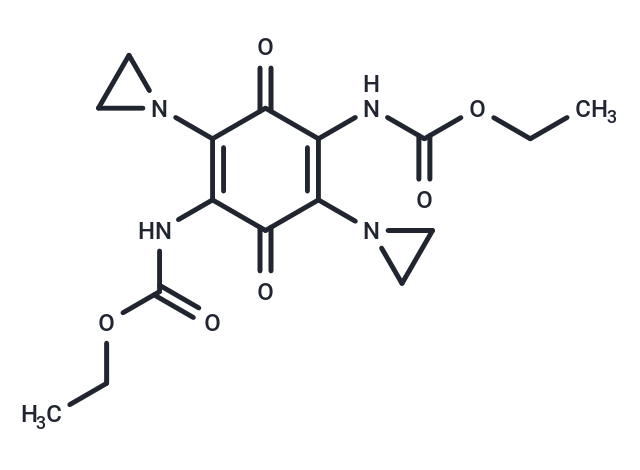Shopping Cart
Remove All Your shopping cart is currently empty
Your shopping cart is currently empty
Diaziquone (NSC-182986) is a water-soluble synthetic azacyclic benzoquinone that enhances penetration of the blood-brain barrier, has antitumor activity, and is used in the treatment of extreme renal failure.

| Pack Size | Price | USA Warehouse | Global Warehouse | Quantity |
|---|---|---|---|---|
| 1 mg | $147 | In Stock | In Stock | |
| 5 mg | $372 | In Stock | In Stock | |
| 10 mg | $596 | In Stock | In Stock | |
| 25 mg | $976 | In Stock | In Stock |
| Description | Diaziquone (NSC-182986) is a water-soluble synthetic azacyclic benzoquinone that enhances penetration of the blood-brain barrier, has antitumor activity, and is used in the treatment of extreme renal failure. |
| In vitro | Diaziquone (5000 ng/mL) is associated with prolonged aplasia and rare instances of bone marrow necrosis, but only mild extramedullary toxicity. One- and three-hour treatments produced little cytotoxicity for hematopoietic versus marrow stromal cells. After six-hour treatments with this dose, marrow was depleted of CFU-Mix, BFU-E, and CFU-GM, but produced CFU-GM in LTMCs, indicating an ongoing input of CFU-GM from a surviving pre-CFU-Mix population. Diaziquone (150 ng/mL; 3 to 7 days) elimination of the latter may be inferred from the absence of CFU-GM in the LTMCs exposed.[4] |
| In vivo | Diaziquone (0.1 mg/day; injection; 4 days) applied topically in Vanicream, Plastibase, or DMSO inhibited tumor growth at day 20 by 66, 86, and 43%, respectively, and cured animals of the skin tumor at a dose of 0.5 mg/day. Diaziquone administered i.p. at 0.5 mg/day for 4 days was lethal to rats, and at 0.1 mg/day it produced 93% inhibition of tumor growth at day 20. Diaziquone was applied topically at 0.1 mg/day for 4 days in Plastibase-cured rats of advanced tumors when treatment was begun 12 days after injection of tumor cells. The area under the plasma radioactivity time curve over 5 h for a single 0.64-mg dose of topically applied [ring-14C]diaziquone in DMSO was 0.01% that of the same dose of [ring-14C]diaziquone administered i.p. in non-tumored rats. The decrease in WBC count following topical application of diaziquone at a dose of 0.1 mg/day for 4 days, compared to the same dose of diaziquone administered i.p., was 62% in Vanicream, 81% in Plastibase and 33% in DMSO. Topical diaziquone was non-toxic to normal skin in the rat and in the domestic pig. It is concluded that topical application of diaziquone offers a therapeutic advantage over systemic treatment for metastatic cancer of the skin.[2] |
| Synonyms | NSC 182986 |
| Molecular Weight | 364.35 |
| Formula | C16H20N4O6 |
| Cas No. | 57998-68-2 |
| Smiles | N(C(OCC)=O)C1=C(C(=O)C(NC(OCC)=O)=C(C1=O)N2CC2)N3CC3 |
| Storage | Powder: -20°C for 3 years | In solvent: -80°C for 1 year | Shipping with blue ice/Shipping at ambient temperature. | |||||||||||||||||||||||||||||||||||
| Solubility Information | DMSO: 45 mg/mL (123.51 mM), Sonication is recommended. | |||||||||||||||||||||||||||||||||||
Solution Preparation Table | ||||||||||||||||||||||||||||||||||||
DMSO
| ||||||||||||||||||||||||||||||||||||
| Size | Quantity | Unit Price | Amount | Operation |
|---|

Copyright © 2015-2026 TargetMol Chemicals Inc. All Rights Reserved.